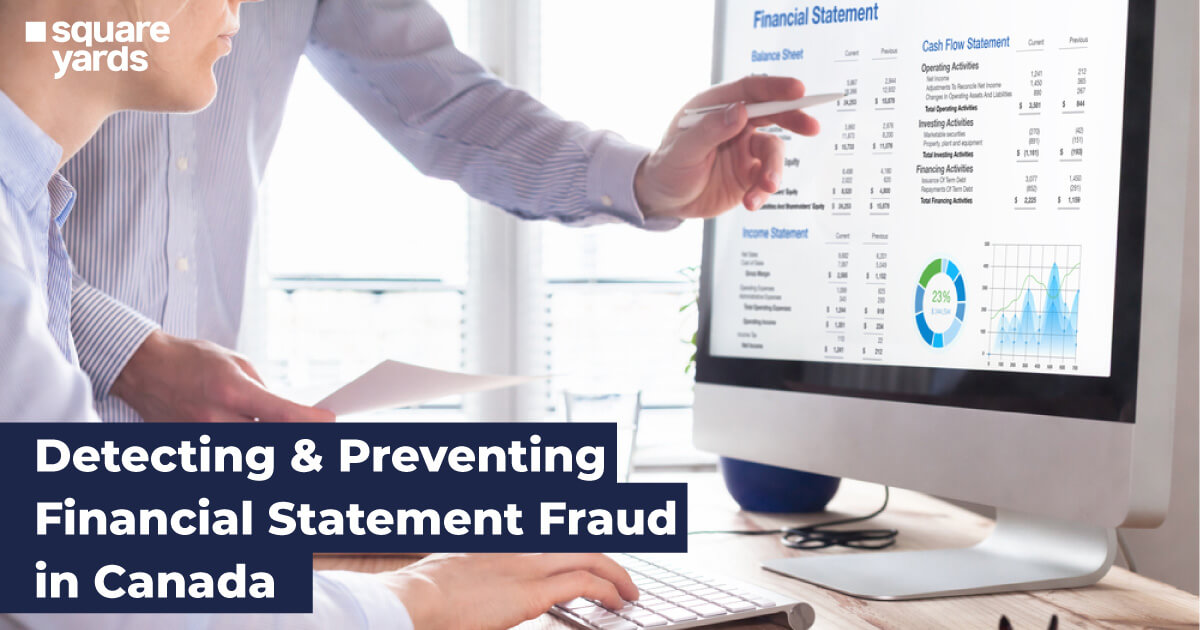‘Financial Statement Fraud’, well, this term might worry you if you don’t know its meaning and prevention measures. But before discussing how you can successfully detect and prevent financial statement fraud, let us understand its meaning, significance, impact and how to detect and prevent it. So without further ado, let us get started.
Understanding The Meaning of Financial Statement Fraud
Financial statement fraud refers to the deliberate misrepresentation of a company’s financial statements. This misrepresentation of financial statement analysis can occur due to many reasons, such as omission/exaggeration to build a positive image of the company’s financial position (i.e. performance and cash flow). In most cases, this misrepresentation is performed by senior-level employees for various reasons. They usually commit this crime for personal gain, to keep the business afloat and to maintain their position as the company’s managerial position.
These swindlers may try to inflate the company’s perceived worth so that the stock looks more lucrative to the investors. The fraudsters also do this to get bank approvals for loans or to give grounds for large salaries and bonuses in case the compensation is tied to company performance. Despite the motive, financial statement fraud causes problems with current and potential investors and shareholders. This can damage the company’s reputation and may result in serious sanctions from the regulators. For instance, the USA Securities and Exchange Commission (SEC) and even arrests.
What Are The Different Types of Financial Statement Fraud?

There are various types of company fraud, such as bribery, kickbacks and payroll fraud. However, in most scenarios, financial statement fraud is concerned with the intentional misrepresentation of accounting information in financial statement analysis. It is usually done so that the share prices, financial data/ other valuation information make the company appear more profitable. The fraudsters manipulate the revenue, expenses, liabilities and assets by the below-mentioned methods:
-
- Overstating Revenue: In this case, the company commits fraud by claiming money as received before the goods and services have actually been delivered. They usually do it by recording future expected sales/ uncertain sales. In case the company has overstated their revenue, it creates a false image of its financial health, which may inflate its share prices.
- Fictitious Revenue and Sales: When the company claims the sales of goods and services that didn’t happen, it falls under the category of fictitious revenue and sales. They do it by double-counting sales, making phantom customers/ overstating/ altering the legitimate invoices of existing customers. The fraudsters can also reverse the false sales at the end of the reporting period to facilitate concealing the deceit. You can also understand it by looking at the infamous Wells Fargo fraud (2016). In this case, the employees started creating millions of checking and savings accounts on behalf of their clients. They did it without the clients’ consent to reach the impossible sales goals.
- Timing Differences: In this type of fraud, the fraudsters understand revenue in one accounting period and then create a reserve which can be claimed in the future, especially during weaker fiscal periods. The other types of this category include posting sales before they are made/ prior to payment, reinvoicing previous due accounts and prebilling for future sales.
- Inflating an Asset’s Net Worth: This type of fraud happens when a company overstates assets by failing to apply a suitable depreciation schedule/ valuation reserve, such as inventory reserves. It can lead to an overstated net income and retained earnings that inflate shareholders’ equity.
- Concealment of Liabilities/ Obligations: Concealment is a form of fraud where the company’s liabilities/ obligations are kept off the financial statements to inflate equity, assets and net earnings. For example, underreported health benefits, salaries and vacation time. The simplest method to conceal these liabilities is by failing to record them.
- Improper or Inadequate Disclosures: The details mentioned in financial statements must be accurate and clear. It is important to note that accounting changes must be mentioned as they have a material impact on the financial statements. Whenever this form of fraud occurs, items like important events, related-party transactions, contingent liabilities and accounting changes are hidden/ omitted from the financial statements.
- Falsifying Expenses: This is yet another type of financial statement fraud, which happens when a company doesn’t completely record their expenses. The net worth of the company is exaggerated, and costs are understated to build a false image of the earned amount of the company’s net income.
- Misappropriations: This is a serious type of financial statement fraud and involves alteration of the financial statements. It is done to hide theft/ embezzlement by double-entry bookkeeping/ including fake expenses. Fraudsters do this so that they can earn more money, unlike other frauds that are done to enrich the business.
A Look at The Indicators of Financial Statement Frauds
Forensic accountants are always on the lookout for early warning signs of financial statement fraud by analysing financial statements. It is important for them to recognise the indicators of suspicious business activities. To better equip themselves, they usually familiarise themselves with common fraud activities. By doing this, they can minimise potential financial statement fraud and reduce the damage. There are many red flags for such fraud like financial, behavioural, organisational and business.
Financial Indicators: One of the most common financial warning signs is whenever an individual/ company ‘cooks the book’. There are some patterns that may appear suspicious and abnormal to financial investigators.
-
- The most predominant indicator of financial statement fraud is the rising revenue without corresponding growth in cash flow.
- Steady growth in sales when their competitors are struggling.
- A sudden spike in the company’s performance in the final reporting period of the fiscal year.
- A major, unaccountable change in assets/ liabilities.
- A bizarre increase in the book value of assets like inventory and receivables.
- Repeated, complex third-party transactions that don’t have any logical business purpose and don’t seem to add value. They also make it difficult to find the actual nature of a particular transaction.
- Missing/ Altered documents.
- The unrecorded invoices in the company’s financial books are also forms of discrepancies and unexplained items and/ or transactions on reconciliation.
- An aggressive form of revenue recognition practice recognises revenue in earlier periods than when the product was sold/ service was delivered.
- An increase in sales without an equivalent increase in inventory/ vice-versa.
- Improper capitalisation of expenses in excess of industry standards.
Behavioural Indicators: As per the Association of Certified Fraud Examiners (ACFE), around 85% of swindlers showed at least one behavioural warning sign while committing their frauds. These warning signs will arise at work and in the swindler’s personal life in the below-mentioned ways:
-
- If a manager/ accountant lives an extravagant lifestyle or has extreme financial troubles.
- A change in the employee’s behaviour (dishonesty, hostility, aggression and unreasonable management attitude).
- If the employee shows control issues, say if he/she is unwilling to share duties related to the company’s finances.
- If the manager shows excessive concern and desperately wants to manage the company’s reputation.
- If they write off the loans given to the executives/ others.
- Inexperienced/ slacked tax management.
- If the person suddenly replaces an auditor.
- If the manager refuses to take time off and is constantly at work.
Organisational Indicators: You can also determine the favourable circumstances for fraudsters by the corporate structure and operational practices of that company. A company whose accounting system and governance is weak is susceptible to the fraudsters. Listed below are some examples for a better understanding:
-
- Recurring changes in the organisation, like a suspiciously high turnover in management/ significant accounting personnel.
- Disproportionate management bonuses on the basis of short-term targets is yet another warning.
- If the major financial decisions are made by only one individual/ jointly made by only a few people.
- A board of directors that is a by-product of nepotism/insiders.
- When the higher authorities put undue importance on meeting quantitative targets.
- In case the individual/ group manually conducts most of the business processes manually rather than the automated process.
Business Indicators: The overall industry downturns and wild divergence from peer company standards of possible fraud are also some of the external factors. A capable auditor will observe business results and the company’s behaviour that appears out of alignment with the overall patterns in that particular industry.
-
- If the profit and/ or operating margins are abnormally higher than the competitors.
- Investing a substantial sum during an industry’s recession or in more fluctuating industries.
- If the revenue is surprisingly high and expenses are extremely low.
- Inflation, interest rates and unemployment are some economic factors that are highly sensitive to operating results.
Detection of Financial Statement Fraud
Detection of financial statement fraud is the primary duty of company management. The company can prevent fraud with a strong audit committee, including internal and external auditors and a board of directors. Auditing standards state that auditors have a duty to establish clear financial statements. They need to find, evaluate and answer fraud risks. Auditors are always on the lookout for any suspicious data by thorough investigation. For these reasons, auditors have a close relationship with numbers. They analyse a business’s financial health by identifying the off-base numbers. To effectively do this, they understand the relationship between certain financial statement balances. Therefore, if you notice, you will see a consistent balance between assets and liabilities in a healthy company. If a company fails to maintain this balance, it means it is trying to hide something. Similarly, a growth in the ratio might imply that the liabilities are being hidden; a downward shift means the business is excessively borrowing.
The cost of goods or services sold (COGS) is a significant ratio as these numbers rise and fall together. If the number of goods sold increases, material and expenses also increase. Sales versus accounts receivables are directly proportional to one another. When the sales grow, the accounts receivables also increase. If the two become inversely proportional to each other, something is wrong and further analysis is required. These analyses are known as comparative ratio analyses and are crucial in spotting accounting irregularities. It is done by measuring the relationship between 2 different financial statement amounts. Current year numbers are used to calculate ratios compared to previous years, other businesses, and the economy. Auditors investigate the matter further in case there is a notable change from year to year/ between entities.
Next up on the list is % analysis, used to evaluate the business’s standing. It is divided into two categories: horizontal and vertical. Horizontal analysis evaluates the % change in individual financial statement items year over year. The first year is taken into account as the base, and the further changes are calculated as % of the base period. Vertical analysis evaluates the relationship between items on any one of the financial statements during 1 reporting period.
A Look at Some Financial Statement Fraud Examples

As per the 2020 Global Fraud Study by ACFE, financial statement fraud’s mean loss is around $954,000. These types of cases come under white-collar crime, for e.g. the Tyco International Scandal. In this 2002 scandal, Dennis Kozlowski (the former CEO and chairman) and Mark Swartz (Corporate CFO) defrauded the company for $600 million. The fraudsters overstated financial results and hid huge amounts of senior executive compensation from investors. The top managerial employees spent a vast sum of money on their own personal expenses and covered their tracks by stopping the internal audits. They also bypassed the company’s legal team when filing disclosure documents with the SEC. Later on, both of them were arrested for this financial statement fraud. Another example of a similar fraud is the Enron Scandal (2001).
How To Prevent Financial Statement Fraud?
Listed below are some tips to prevent financial statement fraud:
-
- Instil Secure Accounting Controls: One should segregate duties and a lot of them to different teams. If a different person audits, reports or deposits money, there’ll be a lesser chance of fraud. This also involves keeping unauthorised personnel out of the accounting system.
- Businesses should conduct periodic audits of financial statements on a regular basis.
- Managers should behave in an honest and moral manner to inspire their subordinates.
- Companies should use ERP (enterprise resource planning) accounting software to automate operations and reduce the chances of error.
- Create an internal reporting/hotline system to easily detect fraud.
- Companies should stop putting more emphasis on achieving short-term goals. This will reduce the mental pressure on the employees, thereby reducing the temptation to commit fraud.
- The company should always keep a check by noticing the details in the employee’s communication.
Ways in Which a Company Can Benefit from Accounting Software
There are a lot of benefits to using ERP as your company’s accounting software. We’ve listed some of them below.
-
- ERP conducts thorough audit-tracking by setting up alerts. It alerts the issue notifications whenever names, addresses/ details of banking change on client accounts/ during irregularity in file integrity.
- ERP also safely keeps the documents and other important data.
- By using ERP, you can easily segregate responsibilities and prevent any fraud.
- ERP can be installed to ask for CFO approval on high-stakes transactions/ transfer of information.
- ERP is user-friendly, so new/ less-experienced employees could also easily use it.
- Many ERP systems can act like an all-in-one cloud business management solution and help your company. For example, NetSuite ERP.
You May Also Read
|
Guide To Steps To Buying a House |
|
|
Know The Smart Financial Planning |
|
|
All About Financial investment in Canada |
|
|
Difference Between TFSA Vs RRSP |
Frequently Asked Questions (FAQs)
inancial statement fraud involves altering the data on a company's financial statements to give the impression of greater profitability. It includes overstating revenue, inflating the value of assets, hiding liabilities and commitments, and making inaccurate disclosures.
Yes, both individuals and businesses found guilty of engaging in financial statement fraud can be subject to legal prosecution. Upon conviction, they may be liable for substantial fines and lengthy terms of imprisonment.
Financial statement fraud aims to deceive those who rely on financial data and present an improved portrayal of the company's financial status, operational performance, and cash flows.
The 5 classifications of financial statement fraud include fictitious revenues, timing differences, improper asset valuations, concealed liabilities and expenses and improper disclosures.
According to the deceit law in Canada, any person who, by deceit/ falsehood, defrauds public market prices (stocks, shares, merchandise) is guilty per the law. How are financial statement frauds committed?
Is falsifying financial statements illegal?
What is the purpose of financial statement fraud?
What are the five classifications of financial statement fraud?
What is the deceit law in Canada?








